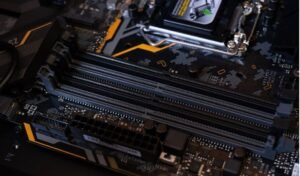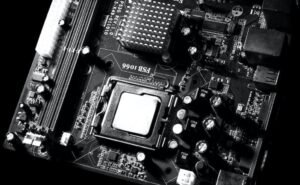AI Dotcom Bubble
Artificial Intelligence (AI) has become a buzzword in recent years, with its applications spanning across various industries. As the technology continues to advance, there are growing concerns that we may be heading towards an AI dotcom bubble. This article explores the current state of AI, the possible risks of overvaluation, and the key factors to consider in order to avoid a repeat of the dotcom crash.
Key Takeaways:
- The AI industry is experiencing significant growth and investment.
- Overvaluation and hype surrounding AI technologies could lead to a potential bubble.
- Investors and policymakers need to be cautious and ensure proper due diligence.
- Learning from the lessons of the dotcom bubble can help prevent a similar crash.
**Artificial Intelligence** holds the promise of transforming industries and revolutionizing the way we live and work. *Companies are racing to develop AI-powered products and solutions*, attracting substantial investment from venture capitalists, corporations, and even governments. The AI market is projected to reach **$190 billion** by 2025, with industries such as healthcare, finance, and retail leading the adoption.
However, there is a growing concern that the AI industry may be heading towards a **dotcom bubble**. In the late 1990s, the dotcom bubble burst, causing many tech companies to go bankrupt. The bubble was a result of overvaluing internet-based companies, fueled by the hype and irrational exuberance of investors. Interestingly, a similar scenario is unfolding in the AI space.
*Companies with shallow AI integration* are often valued at astronomical levels due to their association with the AI buzzword. **Investors** are pouring money into AI startups, hoping to strike it big when the technology takes off. While this illustrates the immense potential of AI, it also raises concerns about overvaluation and unrealistic expectations.
**History** has shown that *hasty investments and overvaluation* can result in a crash. To avoid a similar fate, it is crucial to consider a few key factors:
- **Evaluate the AI company’s technology:** It is important to understand the depth and maturity of the AI technology being developed by a company.
- **Assess the market need:** Determine if there is a genuine market need for the AI product or solution being offered.
- **Consider the competitive landscape:** Analyze the competitors in the market and their potential to disrupt the industry.
AI’s potential is undeniable, with its ability to automate processes, improve decision-making, and enhance productivity. However, it is crucial to approach the AI industry with cautious optimism and avoid falling into the trap of a speculative bubble. By learning from the lessons of the dotcom bubble, we can navigate the AI landscape more effectively and ensure sustainable growth in the industry.
| AI Market Projections | AI Market Share by Industry |
|---|---|
|
Year 2018 2025 |
Industry Healthcare Finance Retail |
|
Market Value ($ billions) 14.7 190 |
Market Share (%) 34 22 18 |
The table above demonstrates the projected growth of the AI market, with healthcare leading the industry adoption and finance and retail following closely behind.
In addition to market projections, it is essential to examine specific use cases and their potential impact:
- **Healthcare:** AI has the potential to revolutionize medical diagnosis, drug discovery, and personalized medicine.
- **Finance:** AI can improve fraud detection, algorithmic trading, and customer service in the financial sector.
- **Retail:** AI-powered recommendation systems, inventory management, and chatbots can enhance customer experiences and optimize operations.
By understanding the market potential and analyzing specific use cases, we can gain a clearer understanding of the AI landscape and the opportunities it presents.
| Key Factors to Consider | Benefits of AI Adoption |
|---|---|
|
|
The **key factors to consider** are listed in the table above, along with the **benefits of AI adoption** that can be reaped by organizations.
While the AI industry is undoubtedly experiencing rapid growth and investment, it is imperative to approach it with caution to avoid inflating a speculative bubble. By carefully evaluating AI companies, assessing market needs, and considering the competitive landscape, we can pave the way for sustainable development and progress in the field of artificial intelligence.

Common Misconceptions
AI is just a passing trend
Many people believe that AI is merely a passing trend that will fade away over time. However, this is a common misconception, as AI has become deeply integrated into various industries and has transformed the way we live and work.
- AI-powered virtual assistants like Siri and Alexa have become a common part of our daily lives.
- AI is being utilized in healthcare for disease diagnosis and drug discovery.
- AI is revolutionizing transportation with the development of autonomous vehicles.
AI will replace humans in all jobs
There is a fear that AI will completely replace human workers in all industries, making jobs obsolete. However, this is an exaggeration. While AI technology can automate certain tasks, it cannot replicate the cognitive abilities, creativity, and emotional intelligence that humans possess.
- AI can automate repetitive and mundane tasks, allowing humans to focus on more complex and strategic endeavors.
- AI can augment human capabilities, enabling professionals to make better decisions and increasing overall productivity.
- AI can create new job opportunities in AI research, development, and maintenance.
AI systems are infallible and unbiased
Contrary to popular belief, AI systems are not infallible, nor are they completely unbiased. AI algorithms are developed by humans, and therefore, they can inherit the biases and limitations of their creators.
- AI systems trained on biased data can perpetuate and amplify existing societal biases.
- AI systems can make errors or display unexpected behavior when faced with unfamiliar situations.
- Ethical considerations and ongoing monitoring are crucial to minimize bias and ensure the responsible development and deployment of AI.
AI is a threat to humanity
Hollywood movies often portray AI as a threat to humanity, leading to the misconception that AI will eventually take over the world and pose an existential threat. However, this dystopian view is far from accurate.
- AI systems are designed to support and augment human activities, not to replace or harm humans.
- The development of AI is heavily regulated to ensure ethical and safe practices.
- AI researchers actively work on developing transparent and interpretable models to mitigate risks and enhance accountability.
AI is only for large corporations
Some people believe that AI is a technology limited to large corporations due to its complexity and cost. However, this perception is no longer true. AI tools and solutions are becoming increasingly accessible and affordable for businesses of all sizes.
- Cloud-based AI platforms are available for small businesses that provide AI capabilities without requiring extensive technical expertise.
- Open-source AI frameworks like TensorFlow and PyTorch enable developers to create AI applications without significant upfront investments.
- AI-focused startups are emerging, providing specialized AI services and solutions to cater to the needs of various industries.

The Rise of Artificial Intelligence
The field of Artificial Intelligence (AI) has been rapidly expanding in recent years, with advancements in machine learning, natural language processing, and computer vision. This article explores the current state of AI and raises the question about whether we are witnessing another dotcom bubble in the industry. The following tables showcase data and insights related to AI and its potential impact on various sectors.
1. AI Investment by Industry
Investment in AI has been steadily growing across different sectors. The table below highlights the top five industries that have seen the highest level of AI investment in recent years.
| Industry | AI Investment (in billions) |
|---|---|
| Healthcare | $9.2 |
| Finance | $7.8 |
| Retail | $6.3 |
| Automotive | $5.9 |
| Technology | $5.2 |
2. AI Adoption in Industries
The adoption of AI technologies varies across industries. The table below demonstrates the level of AI adoption in different sectors based on industry surveys.
| Industry | Level of AI Adoption |
|---|---|
| Manufacturing | High |
| Customer Service | Medium |
| Transportation | Low |
| Education | Low |
| Marketing | Medium |
3. AI Job Market
The growing AI industry has led to an increasing demand for specialized professionals. The table below illustrates the top five AI-related job titles and their average annual salaries.
| Job Title | Average Annual Salary |
|---|---|
| Data Scientist | $120,000 |
| AI Engineer | $110,000 |
| Machine Learning Engineer | $105,000 |
| AI Research Scientist | $130,000 |
| AI Product Manager | $115,000 |
4. AI Patent Growth
Patents are indicative of innovation and investment in the field of AI. The table below displays the growth of AI-related patents by major technology companies over the past five years.
| Company | Number of AI Patents (2015) | Number of AI Patents (2020) |
|---|---|---|
| IBM | 605 | 1,315 |
| Microsoft | 400 | 930 |
| 790 | 1,520 | |
| Amazon | 230 | 720 |
| 150 | 460 |
5. AI Startups Exit Value
The success of AI startups can be measured by their exit value, which includes acquisitions and initial public offerings (IPOs). The table below showcases the top five AI startup exits and their respective values.
| Company | Exit Value (in billions) |
|---|---|
| DeepMind | $500 |
| Nervana Systems | $350 |
| Wonder Workshop | $280 |
| Skysafe | $250 |
| Textio | $180 |
6. AI Ethics Guidelines
Ensuring the ethical use of AI has become a crucial aspect. The table below presents key AI ethics guidelines issued by prominent institutions and organizations worldwide.
| Institution/Organization | Ethics Guidelines |
|---|---|
| European Commission | AI Transparency, Accountability, and Privacy |
| IEEE | Ethically Aligned Design |
| FAT* Conference | Fairness, Accountability, and Transparency |
| AI Principles | |
| OpenAI | Cooperative Orientation |
7. AI Consumer Trust
Consumer trust is vital for the widespread adoption of AI technologies. The table below demonstrates the level of trust in AI among different demographics.
| Demographic | Level of Trust in AI |
|---|---|
| Millennials | High |
| Generation X | Medium |
| Baby Boomers | Low |
| Senior Citizens | Low |
| Generation Z | High |
8. AI Risks and Challenges
Despite its potential, AI poses several risks and challenges. The table below outlines the key concerns associated with AI development and deployment.
| Challenges | Key Concerns |
|---|---|
| Job Displacement | Unemployment |
| Bias and Discrimination | Unfair AI decision-making |
| Privacy and Security | Data breaches and misuse |
| Ethical Implications | Moral dilemmas and accountability |
| Regulatory Frameworks | Insufficient laws and regulations |
9. AI in Pop Culture
AI has captured the imagination of popular culture through films, books, and music. The table below presents notable examples of AI depicted in different forms of media.
| Medium | Notable AI Depiction |
|---|---|
| Film | “HAL 9000” from 2001: A Space Odyssey |
| Literature | “Samantha” from Her by Spike Jonze |
| Music | “Paranoid Android” by Radiohead |
| Television | “Dolores Abernathy” from Westworld |
| Video Games | “GLaDOS” from Portal |
10. AI Future Predictions
Experts and futurists have made various predictions about AI’s impact on society. The table below showcases some of the diverse predictions for the future of AI.
| Expert/Futurist | Prediction |
|---|---|
| Elon Musk | “AI will surpass human intelligence in the next decade.” |
| Ray Kurzweil | “Humans will merge with AI, becoming cyborgs.” |
| Yuval Noah Harari | “AI will disrupt our job market, leading to social upheaval.” |
| Andrew Ng | “AI will transform every major industry, creating new possibilities.” |
| Mary Barra | “AI will revolutionize transportation, enabling autonomous vehicles.” |
Conclusion
The expansion of Artificial Intelligence has ignited significant investment, adoption, and innovation across various industries. Companies are embracing AI as a means to improve efficiency, increase profits, and enhance customer experience. However, the rapid growth of the AI industry does raise concerns about potential risks and challenges, such as job displacement and ethical implications. It’s essential for policymakers, companies, and society as a whole to strike a balance between technological advancements and ensuring responsible and equitable AI deployment. As the AI landscape continues to evolve, it is crucial to monitor the industry’s development and address the potential pitfalls while harnessing the transformative power of AI.
Frequently Asked Questions
What is the AI dotcom bubble?
The AI dotcom bubble refers to the period of technological hype and investment frenzy in the late 1990s and early 2000s when several internet-based companies focused on artificial intelligence (AI) experienced rapid growth and high valuations. However, this speculative market eventually collapsed, leading to the downfall of many AI-focused dotcom companies.
What caused the AI dotcom bubble?
The AI dotcom bubble was caused by a combination of factors. Firstly, there was a rapid growth in internet usage, sparking enthusiasm for online businesses. This led to excessive investment in AI technologies without proper evaluation of their potential and profitability. Additionally, inflated stock prices, unrealistic business models, and a lack of sustainable revenue streams contributed to the bursting of the bubble.
How did the AI dotcom bubble impact the technology industry?
The AI dotcom bubble had both positive and negative impacts on the technology industry. It brought a wave of innovation, encouraging the development of new AI technologies and the exploration of their potential applications. However, when the bubble burst, it caused a significant decline in investment and confidence in the sector, leading to a slowdown in technological advancements and the consolidation of the industry.
What lessons were learned from the AI dotcom bubble?
The AI dotcom bubble taught several valuable lessons. It highlighted the importance of realistic and sustainable business models, proper evaluation of technology, and the need for clear revenue streams. It also emphasized the significance of long-term vision and sincere understanding of the market before investing substantial amounts of capital in AI ventures.
Are there parallels between the AI dotcom bubble and the current AI industry?
While some similarities exist, it is important to note that the current AI industry is fundamentally different. The current advancements in AI are built on more mature technologies and a deeper understanding of their potential applications. Additionally, businesses today are more focused on integrating AI into existing models rather than relying solely on AI-based companies, reducing the risk of a similar bubble phenomenon.
What steps are being taken to prevent another AI dotcom bubble?
The industry has learned from past experiences, and various measures are being taken to prevent a recurrence of the AI dotcom bubble. Investors and entrepreneurs are being more cautious in evaluating the potential of AI technologies, ensuring realistic business models, and identifying sustainable revenue sources. Regulatory bodies also play a role in preventing excessive speculation and fraud in the industry.
Is the AI industry overhyped today?
The AI industry does experience a certain level of hype today, similar to any emerging technology. However, it is important to distinguish between hype and genuine progress. While there may be some exaggerated claims and expectations, the advancements and real-world applications of AI today demonstrate substantial potential and are backed by significant investments and research.
What are some key areas of AI development today?
AI development today encompasses various areas such as machine learning, natural language processing, computer vision, robotics, and deep learning. These areas have seen significant progress and application in fields like healthcare, finance, transportation, and customer service. The AI industry continues to explore new avenues for innovation and growth.
Can another bubble occur in the AI industry in the future?
While it is always a possibility, there are several factors that make the occurrence of another AI bubble less likely. The industry now benefits from valuable lessons learned from the AI dotcom bubble, increased maturity of AI technologies, and more realistic business models. Ongoing efforts to regulate and monitor the industry also play a role in mitigating the potential for another bubble.
How can individuals and businesses navigate the AI industry effectively?
To navigate the AI industry effectively, individuals and businesses should thoroughly research and understand AI technologies, their potential applications, and limitations. It is crucial to evaluate the credibility and expertise of AI vendors or partners, ensuring alignment with business goals and sustained value generation. Continuous monitoring of industry trends and developments is also helpful in making informed decisions.





